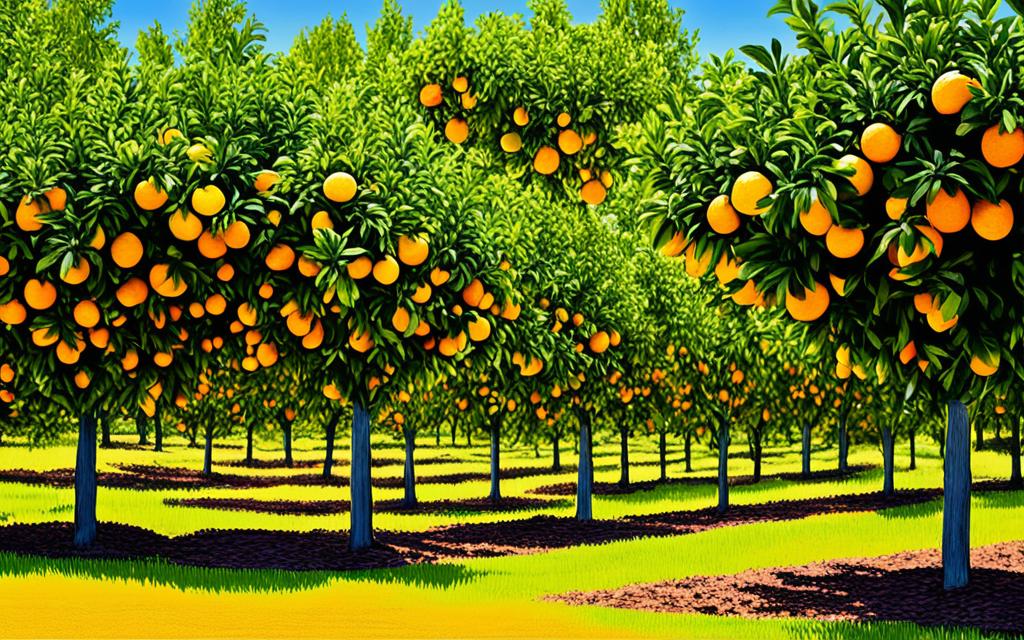Have you ever wondered which came first: the color orange or the fruit? The vibrant hue of orange and the juicy sweetness of oranges both have captivating histories and origins. In this article, we will delve into the fascinating relationship between the color orange and the fruit, exploring their intertwined pasts and shedding light on their origins.
Key Takeaways:
- The color orange and the orange fruit have captivating histories and origins.
- Understanding the origins of the color orange can provide insights into its connection to the fruit.
- The orange fruit has a rich history of cultivation and significance throughout time.
- Exploring the relationship between orange color and the fruit reveals cultural and symbolic connections.
- The vibrant hue of oranges and the citrus fruit are interconnected, and understanding their characteristics deepens our understanding of both.
The Origins of the Color Orange
Have you ever wondered about the origin of the color orange? In this section, we will delve into the historical order and chronology of this vibrant hue, tracing its roots back through time. By understanding how the color orange came to be known and recognized, we can gain insights into its connection to the fruit that shares its name.
Orange is believed to be one of the youngest colors in human history. Unlike colors like red, blue, and yellow, which have ancient origins and can be found in nature, the color orange was not as widely recognized until relatively recently. The development of the color orange as we know it today can be attributed to the historical progression of pigments and dyes.
In ancient times, the color orange was often obtained through the use of natural pigments derived from minerals and plants. These pigments produced a range of hues similar to orange, but the color itself was not specifically named or distinguished. It wasn’t until the Renaissance period that the color orange started to receive more attention and recognition.
During the Renaissance, artists began to experiment with new pigments imported from distant lands. One of these pigments, known as “realgar,” had a rich orange hue that captivated artists and patrons alike. The popularity of realgar led to the increased use of orange in artwork and fashion during this period.
Over time, the color orange became more widely recognized and associated with certain objects and concepts. The citrus fruit, which shares its name with the color, played a significant role in solidifying the association between the fruit and the hue. As the fruit gained popularity and its cultivation spread across the world, so too did the recognition and use of the color orange.
As societies and cultures evolved, so did the perception and symbolism of the color orange. Today, orange is often associated with energy, warmth, and creativity. Its vibrant and eye-catching nature makes it a popular choice for branding and advertising.
Understanding the historical order and chronology of the color orange allows us to appreciate its significance and the role it plays in our lives. In the next section, we will turn our attention to the origins of the orange fruit and explore its captivating history.
The Origins of the Orange Fruit
The rich history of the orange fruit dates back centuries, with its cultivation and significance evolving over time. Let’s delve into the origins of this delicious citrus fruit and explore its fascinating journey.
The orange fruit, scientifically known as Citrus × sinensis, belongs to the Rutaceae family and is believed to have originated in Southeast Asia, specifically in what is now known as China. It is thought to be a hybrid of pomelo (Citrus maxima) and mandarin (Citrus reticulata), resulting in a unique and flavorful fruit.
Historical records indicate that oranges were cultivated and enjoyed by ancient civilizations, including the Egyptians, Greeks, and Romans. The sweet and tangy taste of oranges made them a prized fruit, often used in rituals, feasts, and medicinal remedies.
During the 15th century, the Portuguese explorers introduced orange trees to Europe during their voyages, specifically to Portugal and Spain. From there, the cultivation of oranges spread throughout the Mediterranean region, eventually reaching the Americas with the arrival of Christopher Columbus.
Today, oranges are grown in various parts of the world, with major producers including Brazil, the United States, Mexico, and Spain. This versatile fruit is not only enjoyed fresh but also used in a wide range of culinary creations, such as juices, desserts, and savory dishes.
To better understand the historical significance of the orange fruit, let’s take a closer look at a table outlining key milestones in its cultivation:
| Milestone | Year |
|---|---|
| Domestication of wild citrus fruits | 3000 BCE |
| Introduction of oranges to Europe | 15th century |
| Arrival of oranges in the Americas | 1493 |
| Development of seedless orange varieties | 19th century |
| Advancements in orange cultivation and production | 20th century |
The image above showcases the vibrant and enticing oranges, providing a visual representation of the fruit’s origins. The orange fruit’s distinct color and juicy flesh make it a beloved citrus variety worldwide.
Next, let’s explore the relationship between the color orange and the fruit, and unravel the intriguing connection between these two elements.
The Relationship Between Orange Color and Fruit
In this section, we will delve into the fascinating relationship between the color orange and the fruit. Let’s explore the similarities and differences between the two, as well as the cultural and symbolic connections that have been established over time.
The Color Orange versus Fruit
When discussing the relationship between the color orange and the fruit, it’s important to acknowledge that the color predates the fruit in terms of recognition and use. The color orange, with its vibrant hue, has been known and utilized by humans for centuries. It is believed that the color derived its name from the fruit rather than the other way around.
Interestingly, the English word “orange” was not widely used to describe the color until the 16th century. Before that, people referred to the color as “yellow-red” or “saffron.” It was only with the introduction of orange-colored fruit to Europe from Asia that the color was assigned the name “orange.”
The Origins of Orange Fruit and Color
To further understand the relationship between the color orange and the fruit, let’s explore the origins of both. The orange fruit, scientifically known as Citrus × sinensis, is believed to have originated in Southeast Asia, specifically in regions encompassing southern China, northeastern India, and Myanmar.
The cultivation and spread of orange trees can be traced back thousands of years, with the fruit eventually making its way to Europe, Africa, and the Americas through trade routes and expeditions. The orange fruit became highly valued for its vibrant color, refreshing taste, and numerous health benefits.
As the orange fruit gained popularity across different cultures, the color also became associated with positivity, energy, and warmth. The bright hue of the fruit, reminiscent of the sun and its radiance, had a symbolic and cultural impact on societies worldwide.
The Cultural and Symbolic Connections
The relationship between the color orange and the fruit goes beyond mere aesthetics. Various cultures have assigned symbolic meanings to both the color and the fruit, further strengthening their connection.
In Western cultures, the color orange is often associated with warmth, enthusiasm, and creativity. It is frequently used to represent autumn, harvest, and abundance. In Eastern cultures, particularly in parts of Asia, the orange fruit is viewed as a symbol of good luck, prosperity, and celebration.
Furthermore, the color orange is often used in branding and marketing to evoke feelings of joy, energy, and excitement. It is no surprise that orange is commonly found in logos and advertisements for products related to food, beverages, and wellness.
To visually represent the relationship between the color orange and the fruit, let’s take a look at the following table:
| Color Orange | Orange Fruit |
|---|---|
| Symbolizes warmth, enthusiasm, and creativity | Symbolizes abundance, refreshment, and good health |
| Associated with autumn and harvest | Associated with prosperity and celebration |
| Used in branding and marketing for food and wellness products | Highly valued for its vibrant color and numerous health benefits |
By exploring the relationship between the color orange and the fruit, we can gain a deeper understanding of their intertwined history and cultural significance. Now that we’ve established this connection, let’s delve even further into the characteristics and significance of the citrus and hue in the following section.
Delving into the Citrus and Hue
When it comes to the captivating color orange, one cannot ignore its close association with the vibrant hue found in citrus fruits, particularly the orange fruit. In this section, we will take a closer look at the factors that give the orange fruit its lively hue and explore how this hue relates to the color orange. By examining the characteristics of the citrus and its hue, we can gain a deeper understanding of their interconnectedness.
The Vibrant Hue of Citrus Fruits
The orange fruit, along with other citrus fruits such as lemons and grapefruits, is widely known for its vibrant hue. This striking color is attributed to the presence of pigments called carotenoids, specifically β-carotene, which is responsible for the orange hue. These pigments play an essential role in the fruit’s photosynthesis process and act as natural antioxidants.
Carotenoids are also found in other fruits and vegetables, but the concentration is particularly high in citrus fruits like oranges. This high concentration of carotenoids gives oranges their distinctive and intense vibrant hue.
In addition to β-carotene, citrus fruits also contain other pigments such as lutein and zeaxanthin, which contribute to the overall color spectrum of the fruit. These pigments not only enhance the visual appeal but also provide various health benefits. Lutein and zeaxanthin, for example, are known for their protective properties against macular degeneration, a common age-related eye disease.
The Color Orange and its Citrus Connection
Now that we have explored the vibrant hue of citrus fruits, let’s dive into how this hue relates to the color orange. The color orange, as we know it, got its name from the fruit. The word “orange” originally derived from the Sanskrit word “naranga,” which was used to refer to the fruit.
Over time, the name of the fruit became synonymous with the color itself. The color orange is often described as warm, energetic, and cheerful, just like the fruit it was named after. It has become associated with concepts such as creativity, joy, and enthusiasm.
The vibrant hue of citrus fruits, especially the orange fruit, has made it a popular choice for visual and design applications. From interior design to branding, the color orange is often used to evoke feelings of excitement, positivity, and vibrancy.
To further illustrate the connection between the color orange and citrus fruits, let’s take a look at the table below:
| Citrus Fruit | Color | Pigments |
|---|---|---|
| Orange | Orange | β-carotene, lutein, zeaxanthin |
| Lemon | Yellow | Lutein, zeaxanthin |
| Grapefruit | Pink/Red | Lycopene, β-carotene, lutein, zeaxanthin |
The table above showcases the distinct colors and pigments found in various citrus fruits, emphasizing the relationship between the color orange and the vibrant hues present in these fruits.

Conclusion
In conclusion, our exploration of the history and relationship between the color orange and the fruit has shed light on this age-old question. Through our research, we have discovered that the orange fruit predates the recognition and naming of the color orange. The fruit was cultivated and enjoyed by civilizations long before the vibrant hue received its official designation.
This finding highlights the fascinating evolution of language and perception throughout history. It shows that humans first recognized and appreciated the fruit’s distinct characteristics, including its vibrant hue, before associating it with a specific color. The color orange, then, acquired its name from the fruit it resembles.
Understanding the origins and interplay between the color orange and the fruit provides valuable insights into cultural symbolism and the fluidity of language. While the fruit itself is naturally occurring, the color orange is a human interpretation of a specific wavelength of light. This relationship between the physical world and our perception of it is intriguing and underscores the intricacies of human experience.



